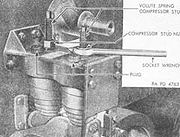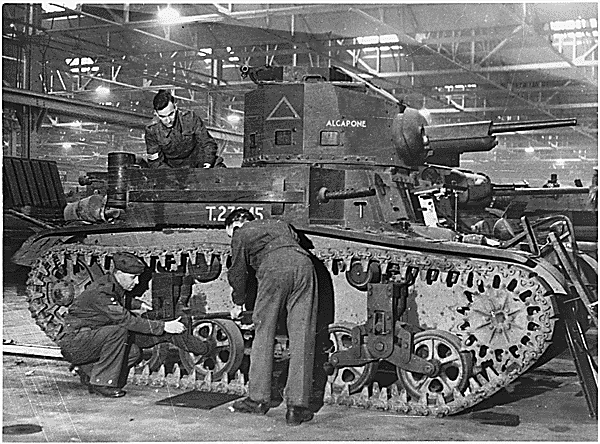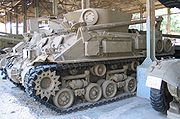
Vertical volute spring suspension
Encyclopedia

Development


Light tank
A light tank is a tank variant initially designed for rapid movement, and now primarily employed in low-intensity conflict. Early light tanks were generally armed and armored similar to an armored car, but used tracks in order to provide better cross-country mobility.The light tank was a major...
s would make US tanks considerably reliable. These included rubber-bushed tracks, rear mounted radial engine
Radial engine
The radial engine is a reciprocating type internal combustion engine configuration in which the cylinders point outward from a central crankshaft like the spokes on a wheel...
s and the vertical volute spring suspension.
A volute spring
Volute spring
A Volute spring is a compression spring in the form of a cone . Under compression, the coils slide past each other, thus enabling the spring to be compressed to a very short length in comparison to what would be possible with a more conventional helix spring.The shape of the initial spring steel ...
is a compression spring
Spring (device)
A spring is an elastic object used to store mechanical energy. Springs are usually made out of spring steel. Small springs can be wound from pre-hardened stock, while larger ones are made from annealed steel and hardened after fabrication...
in the form of a cone (a Volute
Volute
A volute is a spiral scroll-like ornament that forms the basis of the Ionic order, found in the capital of the Ionic column. It was later incorporated into Corinthian order and Composite column capitals...
). Under compression the coils slide over each other, affording longer travel. The result is more stable and powerful than any leaf, coil, or torsion bar spring in the same volume. Mounted vertically in a road wheel bogie for a pair of road wheels in a tank made a very compact unit.
The Rock Island Arsenal produced a small tank for the cavalry which used vertical volute spring suspension instead of leaf spring suspension. Standardized as the M1 Combat Car, it entered service with the US Army in 1937. The design was used in the M2 Light Tank
M2 Light Tank
The Light Tank M2 was an American pre-World War II light tank that saw combat with the US Marine Corps 1st Tank Battalion on Guadalcanal in 1942, during World War II. Its service with the 1st Tank Battalion during the Pacific War was its only U.S...
and subsequent Stuart tank
Stuart tank
The M3 Stuart, formally Light Tank M3, was an American light tank of World War II and supplied to British and Commonwealth forces under lend-lease prior to the entry of the U.S. into the war—and used thereafter by U.S...
series. Design features of the Stuart were scaled up for use in the first M2 Medium Tank
M2 Medium Tank
The Medium Tank M2 was a United States Army tank that was first produced in 1939 by the Rock Island Arsenal, just prior to the commencement of the war in Europe. Production was 18 M2 tanks, and 94 slightly improved M2A1 tanks, for a total figure of 112...
s which would evolve into the more successful M3 Lee
M3 Lee
The Medium Tank M3 was an American tank used during World War II. In Britain the tank was called "General Lee", named after Confederate General Robert E. Lee, and the modified version built with a new turret was called the "General Grant", named after U.S. General Ulysses S. Grant.Design commenced...
and M4 Sherman
M4 Sherman
The M4 Sherman, formally Medium Tank, M4, was the primary tank used by the United States during World War II. Thousands were also distributed to the Allies, including the British Commonwealth and Soviet armies, via lend-lease...
, all using the VVSS.
Replacement
Battle experience showed a relatively short life of the original vertical volute spring suspension (VVSS) of the late models M3s due to the tank's increasing combat weight with larger guns and larger tracks. After mid-1944, M4A3 models of the Sherman adopted a newly developed Horizontal Volute Spring Suspension (HVSS). This type of suspension involved springing the pair of dual road wheels on each bogie against each other with a volute spring. When the horizontal volute springs were placed in compression by either the front or rear bogie wheel arm, the load was transmitted to the opposite arm. This kept tension on the track. Compared to the vertical volute spring suspension which it replaced on the US M4 Sherman, HVSS was heavier, but stronger, allowed the changing of individual wheel and increased wheel travel.
See also
- Christie suspensionChristie suspensionThe Christie suspension is a suspension system developed by American engineer Walter Christie for his tank designs. It allowed considerably longer movement than conventional leaf spring systems then in common use, which allowed his tanks to have considerably greater cross-country speed and a lower...
- Horstmann suspensionHorstmann suspensionHorstmann suspension is a type of tracked suspension devised by the British engineer Sidney Horstmann in 1922.The system uses coil springs and has the advantages of a relatively long travel and, consisting of a self-contained bogie that is bolted to the hull, causing little or no encroachment on...
- torsion bar suspension
- Continuous track

